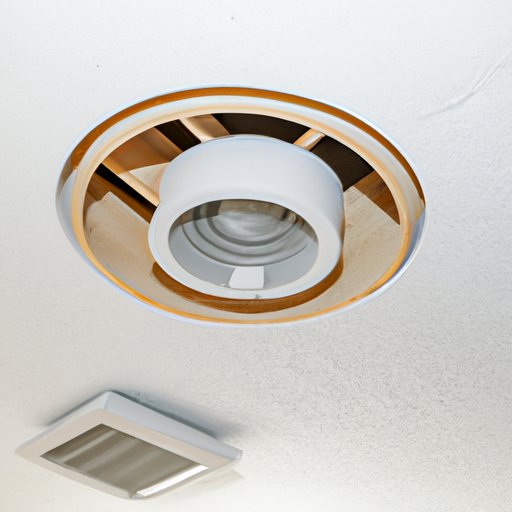Introduction
A bathroom fan is an essential part of any bathroom. It helps remove moisture from the air and prevent mold, mildew, and other bacteria from growing in the bathroom. The most effective way to vent a bathroom fan is to exhaust it outdoors. But where should you vent your bathroom fan? In this article, we’ll explore the different options for venting a bathroom fan and how to decide which one is best for your home.
A Guide to Different Options for Venting Bathroom Fans
There are three main ways to vent a bathroom fan: through the roof, through the wall, or through the soffit. Each option has its own advantages and disadvantages, so it’s important to consider all of them before making a decision.
Through the Roof
Venting a bathroom fan through the roof is the most popular and cost-effective option. This method requires the least amount of labor and materials, as it simply involves installing an exhaust vent on the roof. This option also allows for a shorter exhaust pipe, which reduces the risk of condensation buildup in the pipe. The downside is that you may need to climb onto the roof to install the vent, which can be dangerous if you’re not experienced in roof work.
Through the Wall
Venting a bathroom fan through the wall is another option, although it’s usually more expensive than venting through the roof. This method involves cutting a hole in the exterior wall and installing an exhaust vent. Installing a wall vent requires more labor and materials than a roof vent, but it can be less visible and easier to access for maintenance. The downside is that the exhaust pipe needs to be longer, which increases the risk of condensation buildup in the pipe.
Through the Soffit
Venting a bathroom fan through the soffit is the least common option, but it can be a good choice if you don’t want to install a vent on the roof or wall. This method involves cutting a hole in the soffit (the underside of the eaves) and installing an exhaust vent. The advantage of this method is that it’s relatively easy to install and doesn’t require much material. The downside is that it can be difficult to access for maintenance, and the exhaust pipe needs to be longer, which increases the risk of condensation buildup in the pipe.

How to Decide Where to Vent Your Bathroom Fan
When deciding where to vent your bathroom fan, there are several factors to consider. First, you should consider the size and layout of your bathroom. If your bathroom is small, it may be easier to vent through the roof or wall rather than the soffit. Second, you should consider the type of ventilation system you need. If you need a powerful system, you may need to vent through the roof or wall. Finally, you should consider any local building codes. Some jurisdictions have specific requirements for venting bathroom fans, so make sure to check with your local government before making a decision.
Pros and Cons of Venting a Bathroom Fan Outdoors
Venting a bathroom fan outdoors has both advantages and disadvantages. On the plus side, venting outdoors will reduce noise levels in the bathroom, improve air circulation, and make the fan more energy efficient. On the downside, venting outdoors can increase the risk of moisture damage to the house, and it can be more expensive upfront since you’ll need to purchase and install an outdoor vent.

Designing an Efficient Bathroom Ventilation System
Once you’ve decided where to vent your bathroom fan, you can start designing an efficient ventilation system. There are several factors to consider when designing a system, including the types of fans, the location of fans, and the ducting materials. For example, you may want to consider using inline fans, which are more powerful and energy efficient than traditional fans. You should also consider using insulated ducting materials, which will help reduce noise levels and keep the air temperature stable.
The Basics of Installing a Bathroom Fan Vent
Installing a bathroom fan vent is a relatively simple process, but it’s important to follow the instructions carefully. First, you’ll need to gather the required tools and materials, such as a drill, a saw, and ducting materials. Then, you’ll need to measure and cut the hole for the vent. Finally, you’ll need to install the vent and seal it properly to ensure that no air leaks out.

Common Mistakes to Avoid When Venting a Bathroom Fan
When venting a bathroom fan, there are several common mistakes to avoid. First, make sure to follow all local building codes. Second, make sure to use the right ducting materials – insulated ducting materials are best. Third, make sure to properly seal both the vent and the exhaust outlets. Improperly sealed outlets can lead to air leaks, which can reduce the efficiency of the fan and allow moisture to enter the house.
Conclusion
Venting a bathroom fan outdoors is the most effective way to remove moisture and improve air circulation in your bathroom. There are three main options for venting a bathroom fan: through the roof, through the wall, or through the soffit. When deciding where to vent your bathroom fan, consider the size and layout of your bathroom, the type of ventilation system you need, and any local building codes. Designing an efficient ventilation system and properly installing a bathroom fan vent will help ensure the fan runs efficiently and safely. Avoiding common mistakes when venting a bathroom fan can help prevent air leaks and moisture damage to your home.


